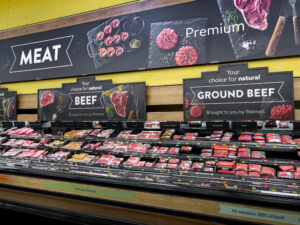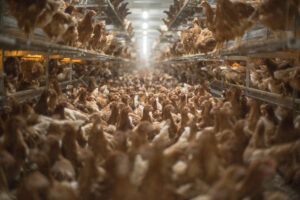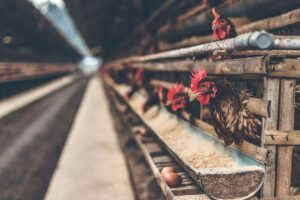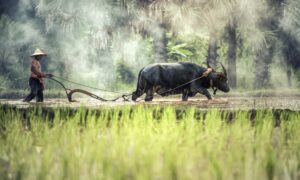What the 2023 Farm Bill Means for Animals and Farmers
A major piece of agricultural legislation will shape the future of the American food system. Farm in North California. Photo: Nikki Ritcher / We Animals Media.
Farm in North California. Photo: Nikki Ritcher / We Animals Media.
This story was originally published by Sentient Media.
Twice every decade, lobbyists, activists, lawmakers and farmers descend upon Capitol Hill to renew the biggest piece of food and agricultural legislation in the United States: the Farm Bill. The Farm Bill is a massive and multifaceted lawmaking endeavor, encompassing everything from crop subsidies and forestry practices to nutrition programs and rural development. The last Farm Bill, which was enacted in 2018, is set to expire on September 30, and negotiations for the upcoming bill have been underway for months.
The 2023 bill is predicted to cost about $700 billion over its five-year lifespan. Clearly, a bill of this size could have a tremendous and potentially transformative impact on the way agriculture is practiced in this country. But for decades, Farm Bills have upheld the status quo by supporting large, industrialized operations at the expense of small-scale farmers – and bolstering practices that harm both animals and the environment. With climate change imperiling food systems across the globe, the 2023 Farm Bill feels more important than ever. But does the bill actually have a chance of producing meaningful change?
Typically, the Farm Bill consists of 12 sections, or titles, relating to farm subsidies, nutrition programs, conservation efforts, rural development, research funding and other miscellaneous projects. The vast majority of Farm Bill spending – about 80 percent in 2018 – goes towards nutrition expenditures, namely SNAP or Supplemental Nutrition Assistance Program benefits.
Commodities, crop insurance and conservation programs are the next-largest chunks of the Farm Bill pie. Roughly eight percent of Farm Bill spending goes towards crop insurance and subsidy programs that provide farmers with protection against things like low prices, sudden price declines and natural disasters.
Though the subsidy program was designed to offer a critical safety net for farmers across the nation, crop subsidies remain disproportionately concentrated on the country’s largest and wealthiest farms. This is in part because of narrow eligibility requirements that make crop insurance virtually inaccessible for most small-scale or beginning farmers – as well as for farmers of healthy foods like fruits, vegetables and nuts. The vast majority of subsidies instead go to producers of major field crops like soy, wheat and corn.
Though past Farm Bills have included legislation that furthers animal welfare in select ways, the law has tended to shy away from major structural changes.
With nearly 70 percent of all soybeans and half of all corn produced in the United States going straight into animal feed, the crop subsidy system has also become a powerful tool for propping up factory farms by providing cheap and reliable feed for the roughly nine billion farmed animals raised and killed in the United States every year. Dairy producers receive subsidies through the Farm Bill via the Dairy Margin Coverage Program.
“If the 2023 Farm Bill looks like the 2018 Farm Bill, then only Big Ag, millionaire landowners and billionaire investors will truly benefit from its factory-food-system approach,” says Alexandra Bookis, the Senior Manager of U.S. Government Affairs at Farm Sanctuary. “It will reinvest in a model that maximizes profits and perpetuates needless suffering, supporting the largest factory farms at the expense of farmers, workers, animals, rural communities and our climate.”
Though past Farm Bills have included legislation that furthers animal welfare in select ways — the 2018 Bill, for example, included laws protecting animals from domestic violence, prohibiting the slaughter of dogs and cats for human consumption and strengthening bans on dogfighting and cockfighting — the law has tended to shy away from major structural changes that could truly transform the lives of farmed animals and benefit the environment in the long-term.
According to the Environmental Protection Agency, agriculture accounts for about 10 percent of all U.S. greenhouse gas emissions. While current EPA data shows that emissions in most other sectors have declined in recent years, agriculture-related emissions have increased by 7.2 percent since 1990. What’s more, animal agriculture is the single largest source of methane emissions in the United States. Though the Farm Bill’s Conservation Title aims to incentivize farmers to implement climate-friendly practices like crop diversification and hedgerows, the Bill is surprisingly flawed when it comes to addressing the impact of factory farming.
The Conservation Title traditionally consists of three main programs: the Conservation Reserve Program (CRP), the Conservation Stewardship Program (CSP) and the Environmental Quality Incentives Program (EQIP). In 1996, the Farm Bill reserved 60 percent of all EQIP funds for livestock operations, but included an express prohibition on any EQIP dollars going to CAFOs, or Concentrated Animal Feeding Operations.
That prohibition, however, was removed in 2002, and millions of EQIP funds – nearly $134 million in 2020 alone – have been funneled towards CAFOs ever since. While some operations do use their EQIP funds to invest in useful conservation practices, a large percentage of CAFOs still use the money to pay for waste lagoons, waste storage spaces, animal mortality facilities and other harmful practices that leach pollutants into the air, water and soil of nearby communities.
“Tens of billions of dollars are invested into the production of animal feed and conservation programs that ultimately serve as government greenwashing by paying factory farms to pollute and then clean up their mess,” says Bookis.
In addition, the Farm Bill has traditionally been more or less silent on one of the simplest known ways to improve animal welfare and curb climate change: reducing meat consumption. Despite the fact that cutting the consumption of meat and other animal products could lead to serious reductions in annual greenhouse gas emissions, the Farm Bill has tended to favor overly-broad advice about “healthy eating” over the concrete diet solutions that could have a real impact on animals and the environment.
Groups are also calling for increased funding for the Conservation Stewardship Program and the Environmental Quality Incentives Program.
In advance of the 2018 Farm Bill’s expiration date, lawmakers and advocacy groups have released platforms and marker bills in the hope that their demands will make it into the final bill come September. While some lawmakers are advocating for incremental changes that may only have a small or temporary impact on the food system, other groups are pushing for an alternative to the Farm Bill altogether.
The most obvious targets for reform are the Bill’s Commodities and Conservation Titles. The National Sustainable Agriculture Coalition (NSAC) is calling for changes that will make subsidies more accessible to a wider variety of producers rather than concentrating payments in a handful of the nation’s biggest (and most environmentally harmful) industrial farms. NSAC also wants to close the loopholes that allow individuals to receive federal subsidy payments even if they are not actively engaged in farming, making the cousins, nephews and nieces of farmers eligible for payments regardless of where they live or work.
Unfortunately, reforming the subsidy system might be harder than it looks, considering the roughly two dozen lawmakers involved in the Farm Bill who have benefited from farm subsidies themselves over the years.
Though the Biden administration aims to shift away from traditional Farm Bill subsidy programs and towards a more sustainable model, advocates say that the administration’s policy is too focused on small, incremental changes that won’t seriously transform the system in the long term. Groups like the Alliance Against Farm Bill Offsets and the NSAC say that buzzy solutions such as methane digesters and methane-reducing feed additives only serve to perpetuate the current harmful system and further the continued consolidation of meat and dairy farms.
Groups are also calling for increased funding for the Conservation Stewardship Program and the Environmental Quality Incentives Program. Though farmer interest in these programs has swelled in recent years, only about a quarter of farmers who applied ended up receiving contracts. More funding for these programs could translate to more farmers integrating sustainable practices into their farms. At the same time, advocates want to make it harder for polluting CAFOs to continue receiving EQIP support.
“Policymakers must curtail subsidies and funding that props up the factory farm system and gives factory farmed products an unfair advantage in the marketplace,” says Lauren Tavar, the director of Farm Animal Legislation for the ASPCA. “They should instead redirect that funding to programs that support and invest in higher-welfare farmers, as well as farmers looking to transition out of the industrial CAFO model.”
Currently, none of the Farm Bill’s 12 massive titles say anything about protecting farmed animals, yet many groups are looking to change that. In their 2023 Farm Bill policy agenda, the ASPCA is calling for a moratorium on new and expanding CAFOs and increased investments in farmers looking to move away from the CAFO model and towards more welfare-informed farms. The ASPCA also wants new animal welfare standards in the transport of livestock and poultry, an end to the poultry exemption in the Humane Methods of Slaughter Act and restrictions on the use of extremely cruel depopulation methods like ventilation shutdown.
“We know that 89 percent of Americans are concerned about industrial animal agriculture and want to support farmers raising animals in more humane systems,” says Tavar. “The Farm Bill can and should become a vehicle for positive change, rather than reinforcing the harmful practices of factory farming.”
On the other side of the spectrum, some lawmakers see the 2023 Farm Bill as a chance to override the Supreme Court’s recent ruling upholding Proposition 12, a California law requiring all pork sold in the state to meet certain animal welfare standards. Industry opposition to Proposition 12 is strong, and lawmakers and government leaders are already hard at work to weaken the landmark ruling’s force.
On June 15, Senator Roger Marshall introduced the Ending Agricultural Trade Suppression, or EATS Act, into Congress. This sweeping act would block individual states from passing laws similar to Proposition 12 that address food safety and animal welfare within their borders, possibly mandating that if any state tolerates a practice – whether it involves gestation grates, puppy mills or pesticides and pollutants – all states must also allow the sale of these products as well. Representative Ashley Hinson plans to introduce a companion bill in the House soon.
On May 18, the Chairman of the House Committee on Agriculture, G.T Thompson, signaled his hope that the 2023 Farm Bill could help negate Proposition 12 and future legislation like it.
The American food system is at a turning point, and the Farm Bill offers a critical opportunity to make decisive change.
“We need to ensure that hardworking farmers and ranchers who put the food on the table…can do so without being unduly burdened by excessive regulation,” Thompson told AgriTalk. “The EATS Act…would prevent states and local jurisdictions from interfering with the production. So I think the act is a pretty good starting point for any legislative solution in the Farm Bill.”
In light of the powerful pro-agriculture forces influencing the Farm Bill, groups like Farm Sanctuary are calling for a full-scale alternative to the bill altogether: the Food and Farm Act. The alternative legislation, spearheaded by Representative Earl Blumenauer, strives to reform each title of the traditional Farm Bill while ending EQIP payments to CAFOs, incentivizing farmers to adopt more humane practices and forcing the USDA to make publicly available any information about entities that violate animal welfare laws.
Though passing such landmark legislation is always a difficult task, especially with a split Congress, it is possible that parts of the Food and Farm Act and other marker bills (such as the Farm System Reform Act and Senator Cory Booker’s package of bills targeting industrialized animal agriculture) will eventually make their way into the final Farm Bill come September.
“A lot has changed since the last bill in 2018,” says Bookis. “We went through a global pandemic that shed light on the brokenness and fragility of the food system supply chain in the United States. The climate crisis has accelerated. And the number of farmed animals in factory farming has increased.”
The American food system is at a turning point, and the Farm Bill offers a critical opportunity to make decisive change. Though we won’t know what the 2023 Farm Bill will look like for several more months, this year’s bill could be a twice-in-a-decade chance to shift priorities in ways that benefit people, animals and the planet.
Your support matters…Independent journalism is under threat and overshadowed by heavily funded mainstream media.
You can help level the playing field. Become a member.
Your tax-deductible contribution keeps us digging beneath the headlines to give you thought-provoking, investigative reporting and analysis that unearths what's really happening- without compromise.
Give today to support our courageous, independent journalists.






You need to be a supporter to comment.
There are currently no responses to this article.
Be the first to respond.